
Water in the Atmospheric Mantle of the Earth
Everywhere in nature the elements of air and water mingle in manifold interplay. Every system of rivers, every lake, every sea, is an organic totality with its own circulation, and to each of these belongs the air space above it. Every river, lake, or sea-coast makes itself felt in the air above it, up to a great height. On misty days a pilot can often see the courses of the rivers as banks of mist below him; but also on days without mist he can tell by the behaviour of his machine when he is flying over a river or lake, or whether he is over a wood or an open stretch of field, for their borders have an effect in the air above.
The air space above a piece of land forms a totality with it, and the air moves accordingly. In summer, air descends over the cool lakes and woods, and ascends over the warmer fields. If there is considerable cooling at night it can happen that the open country becomes cooler than neighbouring woods or stretches of water, so that the movements of air are reversed in a rhythm of day and night. The air is always ascending over the warmer land and descending over the cooler. Circulations arising in the air spaces over a tract of land express something of its life and belong to it entirely.

Air currents over woodland and open field
There are circulations like this in the whole atmosphere of the earth. What takes place on a small scale over woods and lakes occurs on a large scale over the oceans; and what takes place over fields and meadows is repeated over the continents. In winter the relationship is reversed on the small as well as on the large scale, because in winter water is warmer than dry land.
These ascending and descending movements of air form the great areas of the earth into a vast organism. The rhythm of day and night in the circulation over a small landscape has its equivalent in the rhythms of the seasons of summer and winter over the whole planet. In the warm season of the year, the air rises over the continents and falls over the seas; in the cold season this movement is reversed. An ascending movement of air is among other things connected with the formation of regions of low pressure, and descending air with regions of high pressure. In this way, towards summer, a great region of low pressure spreads out over the Central Asian continent, which towards winter becomes transformed into a region of high pressure centred over Asia. These processes are an integral part of the great seasonal breathing of the earth, as described by Wachsmuth.
In connection with the movements of air we have just described, there is also an expansion and contraction according to heat or cold which occurs in the rhythms of the seasons. The meteorologists speak of the ‘breathing of the continents’. In the transition periods between summer and winter, in other words, in spring and autumn, the transformation or changeover of the so-called stationary regions of high and low pressure takes place; summer and winter meet in rhythmical combat.
The regions of high and low pressure are by no means simply regions in which air ascends or descends. The air masses of these regions are caused to follow a spiralling course by the revolution of the earth, whereby the spiral movement of the vortex appears even on this enormous scale. The spiralling formation that so often accompanies movement appears here, too.
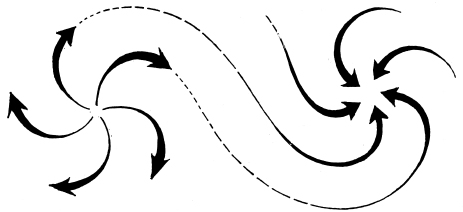
Regions of high and low pressure.
High: descending winds spreading out over the ground
Low: winds converging over the ground and then ascending
If we were to imagine ourselves situated high above the surface of the earth and presume that we were able to perceive the air currents in the summer as they ascend over the continents and descend over the oceans, we should be presented with an extremely varied picture. Embedded in the spacious movements of the atmospheric mantle of the earth we should see, like many ‘organs’, the smaller circulatory systems of air over the different parts of the land, over woodland, field, lake, river, mountain or valley. We should see the picture of a great organism in which the smaller ‘organs’ are embedded, every one connected with all the others, all connected together through a lively interplay of movements and currents in the air.
We have already met with the picture of an organism like this in water, in the interplay between sources and sinks, where forms of an organic nature are created. In the air the ascending and descending currents, as seen from a height, correspond to these sources and sinks. They translate the variations of the landscape below them into an interplay of ascending and descending movements in the air. In this way earth, air and water are united in one great whole in which each preserves its own nature and yet moves together with the others, becoming alive in the great and small rhythms of summer and winter, day and night. Indeed, each movement in the air during the course of a day has a rhythm of its own; all the many ascending and descending movements take place not uniformly but in rhythmically repeated thrusts. It is as though, in separate delicate breaths, the landscape were to ‘speak’ into the air around it.
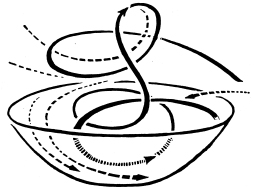
Wind in an area of low pressure (after Blanc)
The question remains as to where in the organism of landscape and earth the surfaces are to be found which in water, in the interplay between sources and sinks, are of such significance. For it is along these surfaces that the rhythmical movements of waves and vortices pass. Surfaces like these may indeed be found in the air.
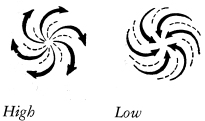
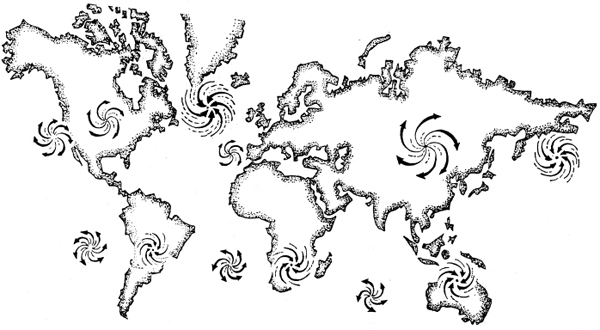
Regions of high and low pressure in January
Wherever in a landscape these ascending and descending currents meet, such invisible surfaces arise. A glider pilot can often recognize them in passing, like delicately turbulent ‘curtains’ that hang, as it were, in the air. They occur, for example, where the landscape below him changes from woodland to open field. They are simply the spiralled surfaces of contact between different masses of air.
In the great spaces of air around the earth similar dividing surfaces arise at the weather fronts, the frontiers between different kinds of air, namely, wherever the regions of influence of the great sources and sinks, the stationary regions of high and low pressure, meet. The same forms that we found when examining water may be found again in the great currents of air around the earth. Everywhere at the surfaces of cloud masses we can detect the play of waves, invaginations and curling movements, which we observed to be the archetypal movements in the formation of organs. We look here into a world of creative processes, in which everything remains in movement, in which organs are laid down but never become solidified, always being taken back again into movement.1

High cloud mass shaped like a living organ, over Europe on 6 March 1943 (after Kleinschmidt)
Processes quite similar to the dropping in of masses of cold air from the poles into the warmer air masses of the lower latitudes may be found in the development of the neural tube or the eye in the human embryo (See Vortex Rings).
It may seem presumptuous to compare processes in the atmosphere with phenomena of organic development. But let us listen to the words of a professional meteorologist. In his book Dynamik der Zyklonen, P. Raethjen writes about the regions of low pressure (cyclones) in the following way: The cyclone ‘has a typical life history with characteristic phases, its origin, development and the way it dies away. It reproduces itself not as the propagation of a wave in space, but—behaving like a living creature— through the “birth” of a young “frontal cyclone” out of the womb (“frontal zone”) of an adult “central cyclone”. [By central cyclone is meant the great stationary regions of low pressure—Author.] ... Only we must not forget that this “dying and becoming” is an essential characteristic of cyclones’. And again: ‘... As the atmosphere behaves like a living creature, it is only fair to consider and treat it as a “whole”. Questions which cannot be understood on their own will find answers when seen in the context of the whole.’ Even earlier than this, well-known meteorologists drew attention to the biological language that weathermen were continually being forced to use.
The rhythms of the above-mentioned trains of vortices in the atmosphere have their own particular laws. The creation of vortices, i.e. regions of low pressure, is a process that follows an annual course with high and low points. According to A. Schmauss, who in a whole lifetime of daily weather observations was able to form a picture of these laws, which he also worked out mathematically, the ‘dynamic year’ begins on 29 September with a low in the activity of the atmosphere. By activity in the atmosphere he means the meteorological movements that approach Europe from between Northern England and France. This is measured by the difference in pressure between these two geographical regions in Western Europe.

Isolation of cold air pockets (after Rossby)
With the beginning of the dynamic year on 29 September an impulse is created that leads the activity of the atmosphere to a climax which is reached, on an average over many years, on 9 January. The activity then decreases again to its lowest point at the end of May or the beginning of June, after this it rises once more and remains high, though varying rhythmically, till 15 September, when it then sinks down until 29 September. There the new impulse of a growing activity begins again, leading up to the climax in January. Thus, the great rise and fall of the regions of high and low pressure in the ‘breathing of the continents’ is rhythmically differentiated still more delicately, like a language or a symphony. Schmauss says of this: ‘For the meteorologist who is acquainted with these things, this calendar of the change in the great bodies of air over the continents has the significance of an orchestral score, which indicates when each instrument should come in. Of course, any instrument can miss its entry: even so, it is a great joy to know the score.’
The important stages in the rhythm of the dynamic year will be seen to correspond with the main festivals of the Christian year. Easter lies in the rhythmical events of the seasons between winter and summer, in the battle between the extremes, and is therefore not very prominent as a single event, as a ‘singularity’. But Whitsun, which falls according to Easter, and has a moveable date, is conspicuous in the course of the dynamic year. Between 20 May and the beginning of June there is a moment of least activity in the atmosphere, a moment which, like Whitsun, does not occur at a fixed date but belongs to this whole stretch of time. Then follows the autumn festival of Michaelmas and then Christmas, which was originally celebrated on 6 January, very near to the singular moment of 9 January, when there is a climax of atmospheric activity. Among the conspicuous points, which have at least a tendency to recur during the course of the year, there are, for instance, the well-known days of frost in May, the cold spell between 2 and 20 June and the thundery period around Ascension Day.
What do such events in the formation of weather and clouds really mean? The realization that these rhythms are extra terrestrial is becoming increasingly widespread. The sequence of cyclones is today considered to be connected with events on the sun, and these, for instance solar activity (sun spots), are considered to be due to the effect on the sun of the interweaving movements of the planets. May not the great cosmic events in the universe have their effect in the ‘sensitive’ surfaces of contact in the atmospheric mantle of our earth? The laws of the heavens address themselves to these membranes as though speaking into delicate ears. Organs are created, and the earth, with its oceans and continents and its landscapes, becomes a great organism. The earth, like a living creature, is received into the still greater living community of the celestial world. If it were possible to look down on land and sea from a great height, we would be able to experience the creation of vortices in the belts of low pressure through the confluence of different masses of air. Where different streams of air meet, waves arise along the surface of contact and then curl in; this all happens in enormous dimensions over the continents and oceans. Sometimes one single such ‘vortex’ has the dimensions of a whole continent.
On the earth we do not experience these spacious movements; we only notice the daily ups and downs of the weather as it passes. Great processes like the battle between different masses of air, for instance, between cold, polar air and warm, humid sea air streaming in from the south, appear to us as the varied, dramatic events of our daily weather. A visible expression of these processes taking place above us is the formation and dissolution of the clouds and the varied kinds of precipitation, which dictate the character of the weather. We have here not only movements which through their interplay create moving forms, but there also occur differences in temperature and, connected with these, the expansion and contraction of the air and the release and absorption of water. This last process is the main incentive for meteorological events, because in it large quantities of heat are absorbed or released, according to the ruling of the celestial universe, which plays its part in the process.
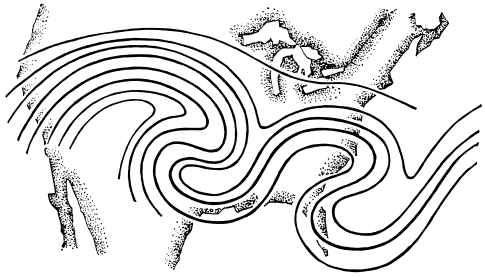
Train of vortices over the U.S.A. (after Wexler and Namias)
The vagaries of the weather are a play with the intermingling of water in the atmosphere. It absorbs great quantities of heat in the warm regions of the earth and either carries this warmth to more northerly latitudes in the form of warm currents in the oceans, or as water vapour in the great air currents of the planet. Where the water meets with cold air it separates out again like a warm breath in the cold winter air, and becomes visible as mist, cloud or precipitation. In this way it releases the huge quantities of heat it had absorbed in warmer regions. As soon as the water becomes visible, the heat it has collected earlier, and usually elsewhere, departs from it once more.
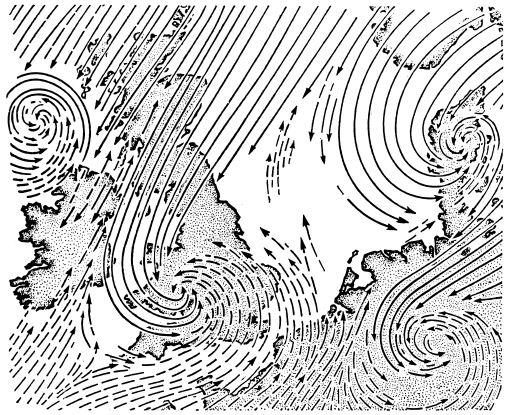
Air currents curl in where streams of warm and cold air meet (after Fitzroy)
So once more we see in water a mediator and balancer between contrasts; it takes what is superfluous at one place and bears it over great distances to where it is needed. Water as the bearer of warmth acts as a great regulator of the gain and loss of heat of the planet. The visible expression of this are the clouds and the weather with all its different elements of pressure, temperature, humidity, wind and so on.
Where in the atmosphere heat pours forth out of the condensing water vapour, it immediately causes ascending currents to arise in the air. It is not necessarily always over warm land that air ascends. Ascending winds can arise in the air itself if water condenses into clouds, thus releasing heat in the midst of the air. The air will then rise up; the higher it rises the more it cools, releasing more water in the form of clouds. Still more heat is thus freed, causing the air to rise still higher. This continued process results in the familiar upwelling cloud formations we see in the summer (Plate 71), gathering and towering up to form thunder clouds. It is simply the interplay of flowing currents, in which the most varied, constantly changing cloud formations arise, reminiscent of animal or organic shapes. The basic principle of organic formation, as we have learned to recognize it, appears here in all its variety of possibilities. Many of the elements of form and movement which we described in connection with water can be found again in connection with the formation of clouds. Waves and rhythmically arranged ridge formations arise when the wind blows across a thin layer of cloud (Plate 73), curling vortices arise at the moving edge of clouds (Plate 75); there are sources and sinks and great and small spiralling surfaces. The little tufts of altocumulus or cirrocumulus clouds, for instance, show where there is an upwelling current. Air rises in each little flake of cloud and falls again at its edge. A great variety of small air circulations spreads out in a field of ‘fleecy’ clouds. If a wind arises that drives the whole field onwards, they arrange themselves in rows, turn into scales that seem to push over one another like ice floes in a river, and create forms that are familiar to us from the varied kinds of ridges and ribs made by water in sand.
We shall refrain from going into all these forms in detail. It will suffice to say that they all arise from movements that we have to a large extent already met with in water.
1 Considerations with regard to unstable surfaces in the atmosphere in connection with nuclear explosions appear in a very notable work by H. Teichmann.